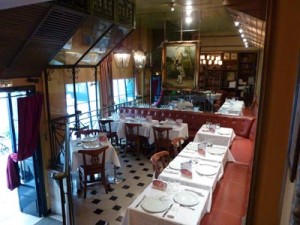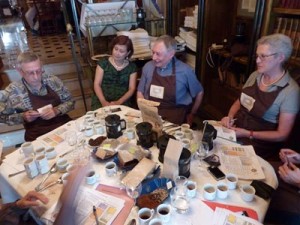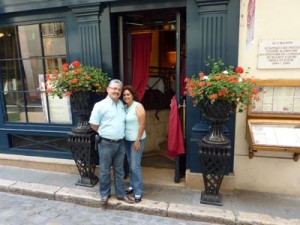In July, I participated in a professional coffee tasting at the oldest coffee house in Paris. Organized by Gloria Montenegro of La Caféothèque de Paris, the event is part of an ongoing effort of an association called Connaissance du Café to teach the art of tasting and appreciating fine coffees grown on specifically identified plantations (cafés fins provenant de terroirs d’appellation). Eight persons showed up for the tasting, plus two coffee growers from Panama—a husband and wife team from the Don Pachi Estate in the Boquete region of the country. They brought with them four different coffees, one of which is the almost-mythical Panama Geisha, considered by some coffee lovers to be the best coffee in the world. There were two “amateurs” at the tasting, a young man named Tony, who wants to open a coffee shop, and me. The others appeared to be professionals in the field of coffee selection by their demeanor, by the content of their conversation…and by the brown aprons that they wore bearing the words “L’Académie de Caféologie.” As the tasting unfolded, I realized that I had a lot to learn about coffee!
First of all, coffee tasting is properly called “cupping.” During cupping, one evaluates coffee by the look of the bean before it is ground, the aroma after it is ground, and the aroma after hot water is poured into the grind. Then each participant is poured a small amount into a cup, from which the aroma and taste are judged. During this evaluation process, one records his appreciations on a specially printed table called “Critères de qualité” (quality criteria). The criteria are quite numerous, and include such things as altitude at which the coffee is grown (in the case of Geicha, it is 1650 meters), visual inspection of the grain, and references to different aromas (spices, flower, cereals, dried fruit, and so on).
We judged five different coffees, the four that the Panamanian couple brought with them and a fifth that was a coffee that can be purchased at supermarkets. Before the tasting started, Gloria introduced the couple and asked them to talk about their coffee plantation. They produce seven or eight different varieties of coffee on their 45-hectare estate whose soil is rich in volcanic minerals. Seventy-five tons of coffee are produced each year. Impressive!
To be continued…
Like our blog? Join us on Facebook!
Tags: coffee tasting, cupping, Procope




